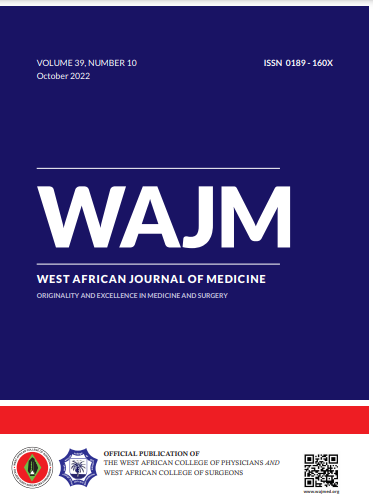ORIGINAL: The Burden of Unsafe Abortion Six Years before the COVID-19 Era in a Nigerian Tertiary Hospital: An Analytical Retrospective Study
West Afr J Med . 2023 Jan 30;40(1):90-96.
Keywords:
Family planning; Illegal/criminal abortion; Maternal morbidity and mortality; Retained product of conception; Unmet need.Abstract
Abstract in English, FrenchBackground: Unsafe abortion remains a leading cause of maternal mortality and morbidity, especially in developing countries with restrictive abortion laws. Disease containment measures during the COVID-19 pandemic have reduced access to contraception and safe abortion care, potentially increasing rates of unintended pregnancies and unsafe abortion.
Objective: To evaluate the morbidity and mortality burden of unsafe abortion before the COVID-19 pandemic.
Methods: A six-year analytical retrospective study of unsafe abortion at the Federal Medical Centre, Lokoja, Nigeria. All case records of unsafe abortion managed within the study period were retrieved, and relevant data extracted using a purpose-designed proforma. Data obtained was analysed using the IBM SPSS Statistics for Windows, version 25 (IBM Corp., Armonk, N.Y., USA). Associations between categorical independent and outcome variables were assessed using the Chi square test at 95% confidence level. A p-value of <0.05 was considered statistically significant.
Results: The prevalence of unsafe abortion was 8.6 per 1,000 deliveries. More than one-half (37, 52.9%) were medical abortions using misoprostol tablets. The mean age of the women was 23.15+ 3.96 years, and most of them were single (49, 70%), with primary/ secondary education (42, 60%), and of low socioeconomic status (67, 95.7%). Nearly one-half (33, 47.1%) had either never used any modern contraceptive (9, 12.9%) or only used emergency contraception (24, 34.3%). The predominant complications of unsafe abortion included retained product of conception (69, 98.6%), haemorrhagic shock (22,31.4%), and sepsis (19, 27.1%). There were two maternal deaths, giving a case fatality rate of 2.9%.
Conclusion: Unsafe abortion remains a significant cause of maternal mortality and morbidity in our setting. Improving access to effective modern contraceptives and liberalizing our abortion laws may reduce maternal morbidity and mortality from unsafe abortion.
Keywords: Family planning; Illegal/criminal abortion; Maternal morbidity and mortality; Retained product of conception; Unmet need.
O D Obadina 1, A E Ubom 2 3, A A Adewole 4, P C Oriji 5, A Musa 1, P O Fiebai 6, T G Onile 1, S Nyeche 6 7, E Gbejegbe 1, S O Sule 1, T O Adebawojo 8, J I Ikimalo 6 7


